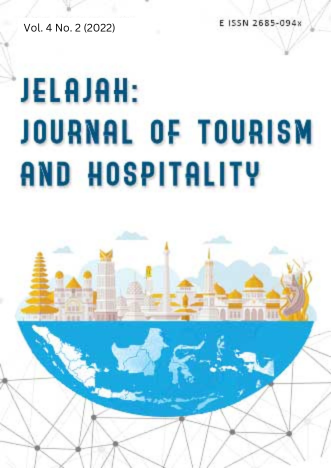THE DEVELOPMENT OF CIPATUJAH BEACH'S POTENTIAL AS A TOURISM DESTINATION IN TASIKMALAYA REGENCY
DOI:
https://doi.org/10.33830/jelajah.v4i2.4074Keywords:
Attraction, Accessibility, Amenity, Ancillary, Sustainability Tourism.Abstract
The purpose of this research is to determine the potency that can be developed in Cipatujah Beach as a tourism destination in Tasikmalaya Regency. The potency of Cipatujah Beach is categorized based on Cooper theory (2000), those are 4 A aspects: attraction, accessibility, amenities and ancillary. Based on the results of data analysis, Cipatujah Beach has been qualified to reach those aspects with the right development plan. The research method that is used in this research is descriptive qualitative method. The techniques of collecting the data are in-depth interview, observation, and triangulation. The technique of analyzing the data is SWOT analysis. The result of this research shows that Cipatujah Beach can be developed as a tourism destination by utilizing those aspects optimally. Besides, cooperation of stakeholders, local people and tourism industry is very required to create a good and systematic development, to keep the tourism sustainability. Tourism sustainability is an appropriate approach of Cipatujah Beach development as a considered tourism destination for the next generation without defaces the originality of tourism destination.
Keywords: Attraction, Accessibility, Amenity, Ancillary, Sustainability Tourism.
References
Arikunto, S. (2013). Prosedur Penelitian Suatu Pendekatan Praktik. Jakarta :Rineka Cipta.
Butler, R., Hall, C. M., & Jenkins, J. (1996). Tourism and recreation in rural areas. John Wiley & Sons Ltd.
Cooper, C et. al (2000). Tourism Principle and Practice. Edisi ketiga. Harlow : Pearson Education Limited
Dutton, I., & , Hall, C. M. (1989). Making tourismsustainable : The policy/practice conundrum. In Proceeding of the Environment Institute of Austarlia Second National Conference (pp. 9-11). Melbourne : Environment Institute Australia.
Gunawijaya, Jajang (2016). Model Pengembangan Dan Kajian Destinasi Wisata Pedesaan Indonesia : Pespektif Antropologi. Depok : Linea
Hadinoto, Kusudianto. (1996). Perencanaan Pengembangan Destinasi Pariwisata. Jakarta: UI Press.
Hanlan, J., Fuller, D., Wilde, S. (2006). Destination Decision Making: The Need For AStrategic Planning And Management Approach. Tourism And Hospitality Planning & Development. Vol. 3 No. 3. 2006 Hal. 209-221.
Hermantoro, H. (2015). Kepariwisataan, Destinasi Pariwisata, Produk Pariwisata. Perpustakaan Nasional RI : Katalog Dalam Terbita.
Keraf, G. (2000). Argumentasi dan Narasi. Jakarta : PT. Gramedia
Meyers, Koen. (2009). Panduan Dasar Pelaksanaan Ekowisata. Jakarta: Unesco Office.
Mill, R.C. dan Morrison, A.M (2009). The Tourism System, edisi keenam. Dubuque : Kendall Hunt Publishing Company.
Mowforth and Munt. (2003). Tourism and Sustanaibility. London and New York: Routledge.
Rangkuti, Freddy. (2005). Strategi Promosi yang Kreatif dan Analisis Kasus Integrated Marketing Communication. Jakarta : Pustaka Utama
Reid, D. (1991). Sustainable Development : An Introductory Guide. Routledge.
Richardson, John dan Martin Fluker. (2004). Understanding and Managing Tourism. New South Wales: Pearson Education.
Sero, A. (2010). Model Pengembangan Pariwisata Bahari Berbasis Masyarakat di Kabupaten Halmahera Utara. Yogyakarta: Kajian Pariwisata: UGM.
Subadra, I. N. (2006). Ekowisata Hutan Mangrove dalam Pembangunan Pariwisata Berkelanjutan. Denpasar: Kajian Pariwisata: Universitas Udayana.
Sugiarto, M, Tonny Hendratono dan Djoko Sudibyo. (2015). Metodelogi Penelitian Hospitaliti & Pariwisata. Tangerang :Matana Publishing
Sugiyono. (2013). Metode Penelitian Bisnis (Pendekatan Kuantitatif, Kualitatif, dan R&D). Bandung: Alfabeta
Sumarno, A. (2012). Perbedaan Penelitian dan Pengembangan. Surabaya : Unesa
Suwantoro, G. (2004). Dasar-dasar Pariwisata. Yogyakarta : Penerbit Andi.
Downloads
Published
How to Cite
Issue
Section
License
Copyright (c) 2022 Hubertina Ngarbingan, Yulita Suryantari

This work is licensed under a Creative Commons Attribution-NonCommercial 4.0 International License.



